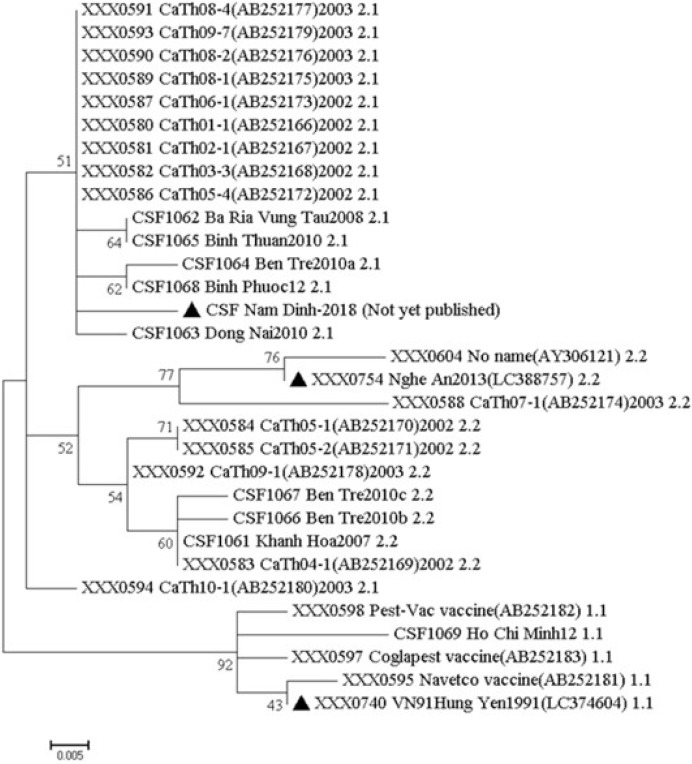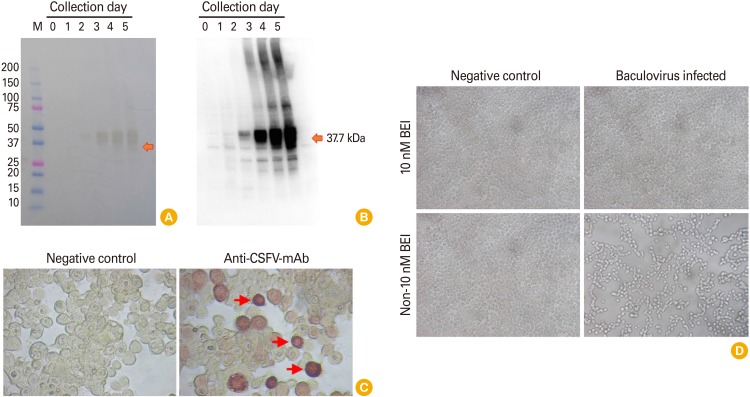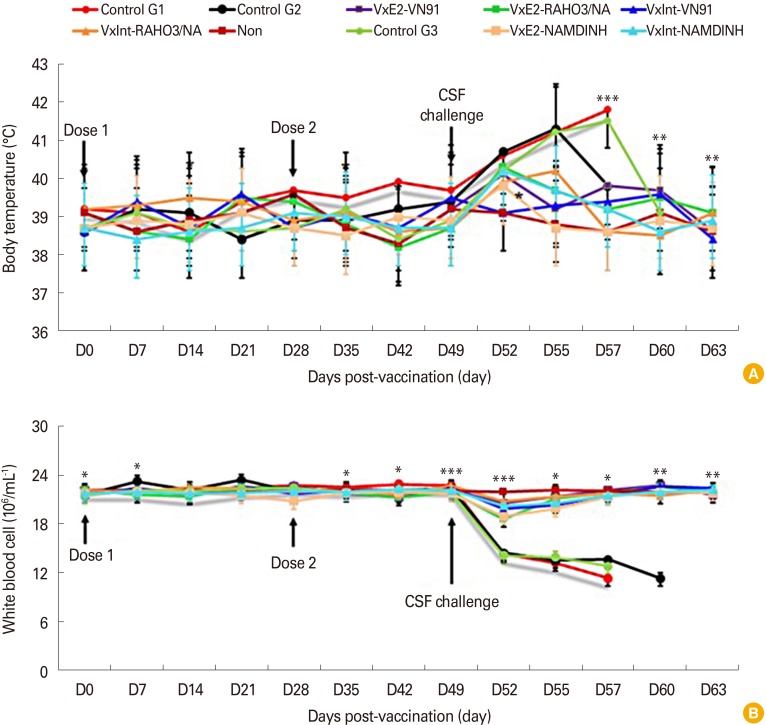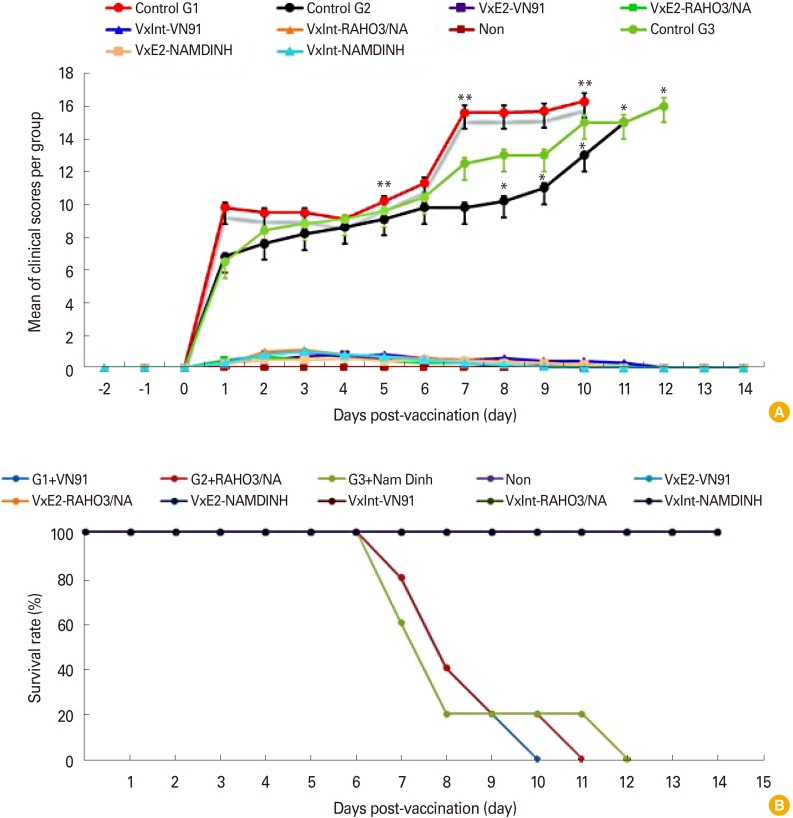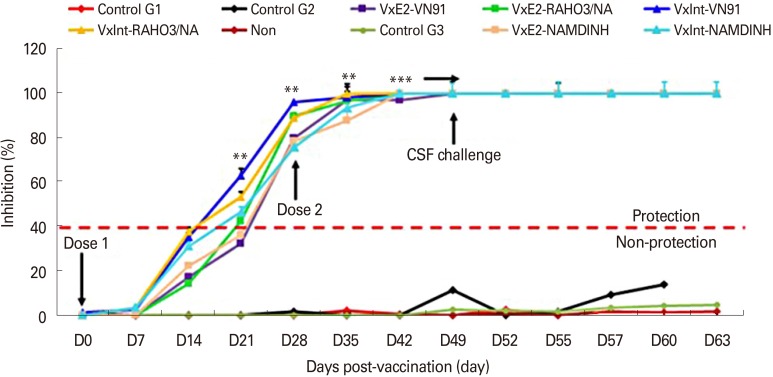Clin Exp Vaccine Res.
2020 Jan;9(1):26-39. 10.7774/cevr.2020.9.1.26.
The potential efficacy of the E2-subunit vaccine to protect pigs against different genotypes of classical swine fever virus circulating in Vietnam
- Affiliations
-
- 1Department of Biochemistry and Immunology, National Institute of Veterinary Research (NIVR), Hanoi, Vietnam. vet.biochem.immuno@nivr.gov.vn
- 2National Institute of Animal Health, The National Agriculture and Food Research Organization, Tsukuba, Japan.
- KMID: 2470835
- DOI: http://doi.org/10.7774/cevr.2020.9.1.26
Abstract
- PURPOSE
To date, many kinds of classical swine fever (CSF) vaccines have been developed to protect against this disease. However, the efficacy of these vaccines to protect the pig against field CSF strains needs to be considered, based on circulating strains of classical swine fever virus (CSFV).
MATERIALS AND METHODS
Recombinant E2-CSFV protein produced by baculovirus/insect cell system was analyzed by western blots and immunoperoxidase monolayer assay. The effect of CSFV-E2 subunit vaccines was evaluated in experimental pigs with three genotypes of CSFV challenge. Anti-E2 specific and neutralizing antibodies in experimental pigs were analyzed by blocking enzyme-linked immunosorbent assay and neutralization peroxidize-linked assay.
RESULTS
The data showed that CSFV VN91-E2 subunit vaccine provided clinical protection in pigs against three different genotypes of CSFV without noticeable clinical signs, symptoms, and mortality. In addition, no CSFV was isolated from the spleen of the vaccinated pigs. However, the unvaccinated pigs exhibited high clinical scores and the successful virus isolation from spleen. These results showed that the E2-specific and neutralizing antibodies induced by VN91-E2 antigen appeared at day 24 after first boost and a significant increase was observed at day 28 (p<0.01). This response reached a peak at day 35 and continued until day 63 when compared to controls. Importantly, VN91-E2 induced E2-specific and neutralizing antibodies protected experimental pigs against high virulence of CSFVs circulating in Vietnam, including genotype 1.1, 2.1, and 2.2.
CONCLUSION
These findings also suggested that CSFV VN91-E2 subunit vaccine could be a promising vaccine candidate for the control and prevention of CSFV in Vietnam.
Keyword
MeSH Terms
Figure
Reference
-
1. Moennig V, Floegel-Niesmann G, Greiser-Wilke I. Clinical signs and epidemiology of classical swine fever: a review of new knowledge. Vet J. 2003; 165:11–20. PMID: 12618065.
Article2. Paton DJ, McGoldrick A, Greiser-Wilke I, et al. Genetic typing of classical swine fever virus. Vet Microbiol. 2000; 73:137–157. PMID: 10785324.
Article3. Gomez-Villamandos JC, Carrasco L, Bautista MJ, et al. African swine fever and classical swine fever: a review of the pathogenesis. Dtsch Tierarztl Wochenschr. 2003; 110:165–169. PMID: 12756959.4. Paton DJ, Greiser-Wilke I. Classical swine fever: an update. Res Vet Sci. 2003; 75:169–178. PMID: 13129664.5. Blome S, Staubach C, Henke J, Carlson J, Beer M. Classical swine fever-an updated review. Viruses. 2017; 9.
Article6. Blome S, Meindl-Böhmer A, Loeffen W, Thuer B, Moennig V. Assessment of classical swine fever diagnostics and vaccine performance. Rev Sci Tech. 2006; 25:1025–1038. PMID: 17361768.7. Van Oirschot JT. Vaccinology of classical swine fever: from lab to field. Vet Microbiol. 2003; 96:367–384. PMID: 14599784.
Article8. Ganges L, Barrera M, Nunez JI, et al. A DNA vaccine expressing the E2 protein of classical swine fever virus elicits T cell responses that can prime for rapid antibody production and confer total protection upon viral challenge. Vaccine. 2005; 23:3741–3752. PMID: 15882536.
Article9. Laughlin RC, Madera R, Peres Y, et al. Plant-made E2 glycoprotein single-dose vaccine protects pigs against classical swine fever. Plant Biotechnol J. 2019; 17:410–420. PMID: 29993179.
Article10. Madera R, Gong W, Wang L, et al. Pigs immunized with a novel E2 subunit vaccine are protected from subgenotype heterologous classical swine fever virus challenge. BMC Vet Res. 2016; 12:197. PMID: 27612954.
Article11. Munoz-Gonzalez S, Sordo Y, Perez-Simo M, et al. Corrigendum to “Efficacy of E2 glycoprotein fused to porcine CD154 as a novel chimeric subunit vaccine to prevent classical swine fever virus vertical transmission in pregnant sows”. Vet Microbiol. 2018; 213:143–149. PMID: 29126749.12. Ahrens U, Kaden V, Drexler C, Visser N. Efficacy of the classical swine fever (CSF) marker vaccine Porcilis Pesti in pregnant sows. Vet Microbiol. 2000; 77:83–97. PMID: 11042402.
Article13. Blome S, Wernike K, Reimann I, Konig P, Mob C, Beer M. A decade of research into classical swine fever marker vaccine CP7_E2alf (Suvaxyn(R) CSF Marker): a review of vaccine properties. Vet Res. 2017; 48:51. PMID: 28915927.
Article14. Eble PL, Geurts Y, Quak S, et al. Efficacy of chimeric Pestivirus vaccine candidates against classical swine fever: protection and DIVA characteristics. Vet Microbiol. 2013; 162:437–446. PMID: 23238022.15. Sanchez O, Barrera M, Farnos O, et al. Effectiveness of the E2-classical swine fever virus recombinant vaccine produced and formulated within whey from genetically transformed goats. Clin Vaccine Immunol. 2014; 21:1628–1634. PMID: 25274802.16. van Aarle P. Suitability of an E2 subunit vaccine of classical swine fever in combination with the E(rns)-marker-test for eradication through vaccination. Dev Biol (Basel). 2003; 114:193–200. PMID: 14677689.17. Suarez M, Sordo Y, Prieto Y, et al. A single dose of the novel chimeric subunit vaccine E2-CD154 confers early full protection against classical swine fever virus. Vaccine. 2017; 35:4437–4443. PMID: 28688785.
Article18. Tran HT, Dang HV, Nguyen DT, Miyazawa K, Kokuho T. Complete genome sequencing of a classical swine fever virus strain endemic in Vietnam. Genome Announc. 2018; 6.
Article19. Troutt AB, McHeyzer-Williams MG, Pulendran B, Nossal GJ. Ligation-anchored PCR: a simple amplification technique with single-sided specificity. Proc Natl Acad Sci U S A. 1992; 89:9823–9825. PMID: 1409706.
Article20. Becher P, Orlich M, Thiel HJ. Complete genomic sequence of border disease virus, a pestivirus from sheep. J Virol. 1998; 72:5165–5173. PMID: 9573288.
Article21. Kumar S, Stecher G, Tamura K. MEGA7: molecular evolutionary genetics analysis version 7.0 for bigger datasets. Mol Biol Evol. 2016; 33:1870–1874. PMID: 27004904.
Article22. Roldao A, Oliveira R, Carrondo MJ, Alves PM. Error assessment in recombinant baculovirus titration: evaluation of different methods. J Virol Methods. 2009; 159:69–80. PMID: 19442848.23. Rueda P, Fominaya J, Langeveld JP, Bruschke C, Vela C, Casal JI. Effect of different baculovirus inactivation procedures on the integrity and immunogenicity of porcine parvovirus-like particles. Vaccine. 2000; 19:726–734. PMID: 11115693.
Article24. Mittelholzer1 C, Moser2 C, Tratschin JD, Hofmann MA. Analysis of classical swine fever virus replication kinetics allows differentiation of highly virulent from avirulent strains. Vet Microbiol. 2000; 74:293–308. PMID: 10831853.25. Meyer D, Loeffen W, Postel A, Fritsche S, Becher P. Reduced specificity of E(rns) antibody ELISAs for samples from piglets with maternally derived antibodies induced by vaccination of sows with classical swine fever marker vaccine CP7_E2alf. Transbound Emerg Dis. 2018; 65:e505–e508. PMID: 29314759.
Article26. Biacchesi S, Skiadopoulos MH, Yang L, Murphy BR, Collins PL, Buchholz UJ. Rapid human metapneumovirus microneutralization assay based on green fluorescent protein expression. J Virol Methods. 2005; 128:192–197. PMID: 15955576.
Article27. Penrith ML, Vosloo W, Mather C. Classical swine fever (hog cholera): review of aspects relevant to control. Transbound Emerg Dis. 2011; 58:187–196. PMID: 21303492.
Article28. Rios L, Coronado L, Naranjo-Feliciano D, et al. Deciphering the emergence, genetic diversity and evolution of classical swine fever virus. Sci Rep. 2017; 7:17887. PMID: 29263428.
Article29. Jiang DL, Gong WJ, Li RC, et al. Phylogenetic analysis using E2 gene of classical swine fever virus reveals a new subgenotype in China. Infect Genet Evol. 2013; 17:231–238. PMID: 23608662.
Article30. Ziegler U, Kaden V. Vaccination of weaner pigs against classical swine fever with the subunit vaccine “Porcilis Pesti”: influence of different immunization plans on excretion and transmission of challenge virus. Berl Munch Tierarztl Wochenschr. 2002; 115:267–273. PMID: 12174723.31. Hulst MM, Westra DF, Wensvoort G, Moormann RJ. Glycoprotein E1 of hog cholera virus expressed in insect cells protects swine from hog cholera. J Virol. 1993; 67:5435–5442. PMID: 8350404.
Article32. Bouma A, de Smit AJ, de Kluijver EP, Terpstra C, Moormann RJ. Efficacy and stability of a subunit vaccine based on glycoprotein E2 of classical swine fever virus. Vet Microbiol. 1999; 66:101–114. PMID: 10227472.
Article33. De Smit AJ, Bouma A, de Kluijver EP, Terpstra C, Moormann RJ. Duration of the protection of an E2 subunit marker vaccine against classical swine fever after a single vaccination. Vet Microbiol. 2001; 78:307–317. PMID: 11182497.
Article34. Dong XN, Chen YH. Marker vaccine strategies and candidate CSFV marker vaccines. Vaccine. 2007; 25:205–230. PMID: 16934915.
Article35. Depner KR, Bouma A, Koenen F, et al. Classical swine fever (CSF) marker vaccine: trial II: challenge study in pregnant sows. Vet Microbiol. 2001; 83:107–120. PMID: 11557152.
- Full Text Links
- Actions
-
Cited
- CITED
-
- Close
- Share
- Similar articles
-
- Toward the development of a one-dose classical swine fever subunit vaccine: antigen titration, immunity onset, and duration of immunity
- Field evaluation of the safety and immunogenicity of a classical swine fever virus E2 subunit vaccine in breeding and nursery animals on Jeju Island, South Korea
- Molecular Cloning and Nucleotide Sequence of the Gene Encoding Gp44 Protein of Suri strain: an Attenuated Classical Swine Fever Virus
- Histopathological Evaluation of the Efficacy for Plant-produced E2 Protein Vaccine against Classical Swine Fever Virus (CSFV) in Piglets
- Antigenic characterization of classical swine fever virus YC11WB isolates from wild boar

